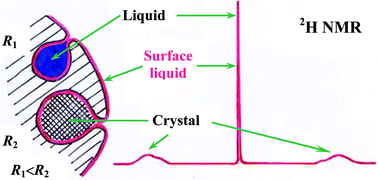Analysis of pore size distribution by 2H NMR
Abstract
The pore size distributions of four controlled pore glasses with mean diameters ranging from ca. 7.9 to 23.9 nm were analysed by measuring the 2H NMR signals from the liquid fraction of confined

* Corresponding authors
a
Faculty of Physics, Vilnius University, Sauletekio av. 9-3, Vilnius, Lithuania
E-mail:
liudvikas.kimtys@ff.vu.lt
Fax: +370 5 2366086
Tel: +370 5 2366003
b Department of Chemistry, University of Bergen, Bergen, Norway
The pore size distributions of four controlled pore glasses with mean diameters ranging from ca. 7.9 to 23.9 nm were analysed by measuring the 2H NMR signals from the liquid fraction of confined

 Please wait while we load your content...
Something went wrong. Try again?
Please wait while we load your content...
Something went wrong. Try again?
L. Kimtys and D. W. Aksnes, Analyst, 2007, 132, 148 DOI: 10.1039/B609805C
To request permission to reproduce material from this article, please go to the Copyright Clearance Center request page.
If you are an author contributing to an RSC publication, you do not need to request permission provided correct acknowledgement is given.
If you are the author of this article, you do not need to request permission to reproduce figures and diagrams provided correct acknowledgement is given. If you want to reproduce the whole article in a third-party publication (excluding your thesis/dissertation for which permission is not required) please go to the Copyright Clearance Center request page.
Read more about how to correctly acknowledge RSC content.
 Fetching data from CrossRef.
Fetching data from CrossRef.
This may take some time to load.
Loading related content
